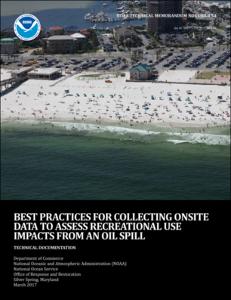| dc.contributor.author | Horsch, E. | |
| dc.contributor.author | Welsh, M. | |
| dc.contributor.author | Price, J. | |
| dc.date.accessioned | 2021-07-30T20:46:40Z | |
| dc.date.available | 2021-07-30T20:46:40Z | |
| dc.date.issued | 2017 | |
| dc.identifier.citation | Horsch, Eric, Welsh, Michael and Price, Jason (2017) Best practices for collecting onsite data to assess recreational use impacts from an oil spill. Silver Spring, MD, NOAA Office of Response and Restoration, 124pp. (NOAA Technical Memorandum NOS ORR, 54), DOI: https://doi.org/10.7289/V5/TM-NOS-ORR-54 | en_US |
| dc.identifier.uri | https://repository.oceanbestpractices.org/handle/11329/1637 | |
| dc.identifier.uri | http://dx.doi.org/10.25607/OBP-1569 | |
| dc.description.abstract | In the aftermath of an oil spill, state and federal natural resource trustees (“Trustees”) often need to assess impacts to recreational use as part of a Natural Resource Damage Assessment (NRDA). A lost recreational use assessment—one component of a broader “Human Use” assessment that can also include financial, cultural, and subsistence losses—measures losses to the public due to a reduced ability to interact with Trust resources. For spills affecting coastal areas, this often means reduced recreational fishing, boating, beach use, and other activities along the coast (e.g. birdwatching, diving, and hunting). For these assessments, data are needed to estimate changes in the amount of recreation at sites potentially affected by the spill. Actual use levels during the spill and the period of recovery (“spill period use”) are compared to use levels that would have occurred if not for the spill (“baseline use”) to determine the change in use. In some cases, existing data sources alone are insufficient to conduct the assessment, and new data must be collected.
This manual provides guidance to Trustees (and responsible parties (“RPs”) in the case of “cooperative assessments”) on the relevant methods and considerations for collecting data for recreational use assessments. While a range of methods may be used, this manual focuses only on onsite data collection using ground personnel and aerial photography. Other methods that may be considered but are not discussed in this manual include mail, telephone, and internet surveys; automated vehicle or people counters; and roving or fixed-point ground photography (see Leggett, 2015). This manual provides several examples, both to illustrate the application of different approaches and to provide ideas and templates for future data collection efforts. The examples cover a range of activities, including general beach recreation (swimming, sunbathing, etc.), shore-based fishing (i.e., saltwater fishing not occurring on sandy beaches), and boating (including pleasure boating and boat-based fishing).
The chapters in this manual address all the necessary steps for onsite data collection: sampling design, developing data collection materials, study implementation (e.g., staffing logistics and safety), field data intake and review, and data entry and processing. | en_US |
| dc.language.iso | en | en_US |
| dc.publisher | United States, National Ocean Service, Office of Response and Restoration | en_US |
| dc.relation.ispartofseries | NOAA Technical Memorandum NOS-ORR;54 | |
| dc.rights | CC0 1.0 Universal | * |
| dc.rights.uri | http://creativecommons.org/publicdomain/zero/1.0/ | * |
| dc.subject.other | BP Deepwater Horizon Explosion and Oil Spill, 2010 | en_US |
| dc.subject.other | Oil spills | en_US |
| dc.subject.other | Oil Pollution | en_US |
| dc.subject.other | Environmental impact analysis | en_US |
| dc.subject.other | Recreation areas | en_US |
| dc.subject.other | Coastal waters | en_US |
| dc.subject.other | Coastal zone management | en_US |
| dc.subject.other | Fishing | en_US |
| dc.subject.other | Boats and Boating | en_US |
| dc.subject.other | Coastlines | en_US |
| dc.title | Best Practices for Collecting Onsite Data to Assess Recreational Use Impacts from an Oil Spill. | en_US |
| dc.type | Report | en_US |
| dc.description.status | Published | en_US |
| dc.format.pages | 124pp. | en_US |
| dc.description.refereed | Refereed | en_US |
| dc.publisher.place | Silver Spring, MD | en_US |
| dc.subject.parameterDiscipline | Anthropogenic contamination | en_US |
| dc.subject.dmProcesses | Data acquisition | en_US |
| dc.subject.dmProcesses | Data processing | en_US |
| dc.description.currentstatus | Current | en_US |
| dc.description.sdg | 14.1 | en_US |
| dc.description.eov | N/A | en_US |
| dc.description.adoption | Organisational | en_US |
| dc.description.methodologyType | Method | en_US |
| dc.description.methodologyType | Specification of criteria | en_US |
| dc.description.methodologyType | Reports with methodological relevance | en_US |
| obps.resourceurl.publisher | https://repository.library.noaa.gov/view/noaa/14165 | |
 Repository of community practices in Ocean Research, Applications and Data/Information Management
Repository of community practices in Ocean Research, Applications and Data/Information Management

